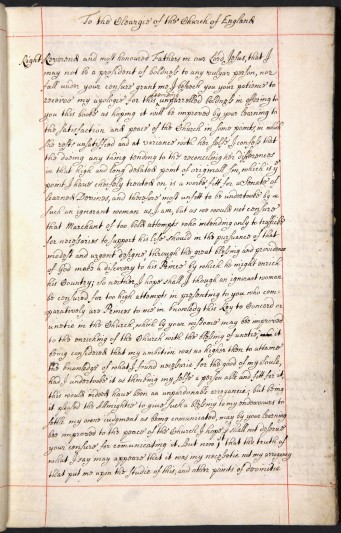The treatise is written in a single neat hand, laid out as if to be ready for the press and preceded by a spiritual autobiography, which identifies the author as ‘an Obedient Daughter and true Member of the Church of England’ and mentions her contacts with the three ‘eminent Divines’, Dr Thomas Soame, Dr Jeremy Taylor and Dr Robert Mossom. Who, then, was this ‘illiterate woman’ whose musings on Original Sin could command the personal written attention of three leading Anglican Doctors of Divinity during the Civil War or soon after, all ardent Royalists, and all deprived of their livings and even their liberty, and two of whom could be persuaded to advise the publication of her arguments despite certain differences of opinion? There was one woman who received just such private written attention, at least from Dr Jeremy Taylor. In 1656 the bookseller Richard Royston published, ostensibly without his authority, Taylor’s Deus Justificatus, or a Vindication of the Glory of the Divine Attributes in the Question of Original Sin. Against the Presbyterian way of Understanding it. It was addressed ‘to the Right Honorable and religious Lady, the Lady Christian, Countesse Dowager of Devonshire’.
Christian[a] Cavendish (née Bruce), Dowager Countess of Devonshire (1595-1675), was the widow of William Cavendish, 2nd Earl of Devonshire (1590-1628), daughter of Edward Bruce, 1st Baron Bruce of Kinloss, sister of Thomas Bruce, 1st Earl of Elgin, and mother of William Cavendish, 3rd Earl of Devonshire (1617-1684), Col. Charles Cavendish (1620-1643) and Henry and Anne Cavendish. Her husband died young and she endured a long widowhood which was much occupied by her concerns for her sons’ education (Thomas Hobbes was their tutor) and the preservation of the Cavendish estates for her elder son from the lawsuits of creditors. From 1638 she lived at Cavendish House, Leicester (the former Leicester Abbey), which was looted and burned in 1645, her second son having been killed by Cromwell’s men at Gainsborough in 1643 and her only daughter, Anne, Lady Rich, having died in 1638, aged 27. From 1647 she lived with her brother the Earl of Elgin at Ampthill in Bedfordshire, before buying an estate at Roehampton in Surrey around 1650 which ‘became a centre of surreptitious activity on behalf of the exiled Charles II’ (ODNB). Following the Restoration, ‘Lady Devonshire presided over an elaborate establishment at Roehampton, welcoming wits, authors, and politicians to her home. ... The Italian visitor Lorenzo Magalotti described her in 1667 as living “in a magnificent house in the style of something more than a great princess”.’
The late 1640s and 1650s saw a sudden explosion of published religious writings by women. These writing were, however, almost exclusively Nonconformist and predominantly Quaker and this phenomenon has been widely studied. There was a much smaller group of royalist women literary writers, headed by Margaret Cavendish, Duchess of Newcastle, who wrote for publication. Anglican women, however, seldom ventured into writing beyond the ‘Mother’s Legacy’ genre, prayers and meditations, or journals/diaries. These were usually intended for private devotion or family use and they were rarely published in their lifetimes. This anonymous woman did what they did not do; using Biblical exposition, she was prepared publicly to challenge one of the key Articles of the Church of England from within.
